Spatial and Temporal Variations of Vegetation Phenology and Its Response to Land Surface Temperature in the Yangtze River Delta Urban Agglomeration
Abstract
1. Introduction
2. Materials and Methods
2.1. Study Area
2.2. Data
2.2.1. EVI Data
2.2.2. LST Data
2.2.3. Precipitation Data
2.2.4. Land Cover Data
2.3. Methodology
2.3.1. Reconstruction of Vegetation Index Time Series
2.3.2. Extraction of Vegetation Phenology Indicators
2.3.3. Methods of Statistical Analyses
- Partial correlation analysis
- 2.
- Geographical weighted regression analysis (GWR)
- 3.
- Considering the spatial heterogeneity in the response of vegetation phenology to LST, we used GWR to analyze the spatial differences in the response of vegetation phenology to LST, with the following formula:where represents the vegetation phenology indicators of raster i, is the intercept, is the coordinate of raster i, k is the number of independent variables, is the regression coefficient of the kth independent variable, is the kth independent variable of raster i, and is the random error.
3. Results
3.1. Spatial and Temporal Patterns of Vegetation Phenology
3.1.1. Spatial and Temporal Characteristics of Vegetation Phenology in the Study Area
3.1.2. Differences in Vegetation Phenology between Land Covers
3.1.3. Differences in Vegetation Phenology by City
3.2. Spatial and Temporal Patterns of LST
3.2.1. Spatial and Temporal Characteristics of LST in the Study Area
3.2.2. Differences in LST between Land Covers
3.2.3. Differences in LST by City
3.3. Response of Vegetation Phenology to LST
3.3.1. Partial Correlation Analysis between Vegetation Phenology and LST
3.3.2. Partial Correlation Analysis between Vegetation Phenology and LST for Different Land Covers
3.3.3. Partial Correlation Analysis between Vegetation Phenology and LST for Different Cities
4. Discussion
5. Conclusions
- Characteristics of spatial and temporal variation in vegetation phenology: (1) Cities located in the area of forests in the south and concentrated impervious surfaces had an earlier SOS, later EOS, and longer GSL, while those in the east and west along the river basins had a later SOS, earlier EOS, and shorter GSL. Analyzing the different land covers showed that forests had the earliest SOS, the latest EOS, and the longest GSL, along with the least volatility in phenological indicators. The cropland had the latest SOS, the earliest EOS, the shortest GSL, and the greatest volatility in vegetation phenology indicators; phenological indicators and the volatility of impervious surfaces are intermediate between forests and cropland. The reasons for these differences may be related to differences in thermal conditions, temperatures, and dominant vegetation types under different land covers. (2) The SOS of the study area from 2002 to 2020 showed a trend of advancement; the EOS showed a trend of postponement; and the GSL showed a trend of lengthening. This trend may have been caused by the gradual increase in LST in the study area.
- Temporal and spatial variability characteristics of LST: (1) The LST in the study area at different times of the year generally showed a trend of gradual decrease from the southeast to the northwest. Cropland has the lowest LST in winter, March, and April; forest LST is higher in winter and March, but the annual mean LST is lower while it is the least volatile; and impervious surfaces have the highest April and annual mean LST, while they are the most volatile. This can be caused by impervious surfaces having more buildings, asphalt, and other surfaces. (2) From 2002 to 2020, winter, March, April, and annual mean LST in the study area showed an increased trend, the trend in elevated LST was most pronounced in March. This increased trend in LST may have been due to global warming and urbanization in the study area.
- Vegetation phenology response to LST: (1) Cropland SOS was delayed with increased LST while forests and impervious surfaces were advanced; this may have been caused by differences in vegetation types under different land covers, as different vegetation responds differently to changes in LST; EOS was mainly delayed as LST increased. (2) Impervious surface vegetation phenology responded most strongly to LST while cropland and forests were less responsive; this may imply that vegetation in impervious surface areas responds more significantly to changes in LST. (3) Cropland responded more strongly to April LST while forests and impervious surfaces responded more strongly to March and April; this may indicate that the SOS response to LST in March and April will be more significant than the response to LST in winter. (4) The response of vegetation phenology to LST was variable, but the years of strong response were relatively concentrated.
Author Contributions
Funding
Data Availability Statement
Acknowledgments
Conflicts of Interest
References
- Xu, H.; Yang, S. Urban heat island effect and urban ecosystems. J. Beijing Norm. Univ. (Nat. Sci.) 2018, 54, 790–798. [Google Scholar] [CrossRef]
- Liu, X.; Huang, Y.; Xu, X.; Li, X.; Li, X.; Ciais, P.; Lin, P.; Gong, K.; Ziegler, A.D.; Chen, A.; et al. High-spatiotemporal-resolution mapping of global urban change from 1985 to 2015. Nat. Sustain. 2020, 3, 564–570. [Google Scholar] [CrossRef]
- Peng, J.; Jia, J.; Liu, Y.; Li, H.; Wu, J. Seasonal contrast of the dominant factors for spatial distribution of land surface temperature in urban areas. Remote Sens. Environ. 2018, 215, 255–267. [Google Scholar] [CrossRef]
- Nayak, H.P.; Nandini, G.; Vinoj, V.; Landu, K.; Swain, D.; Mohanty, U.C.; Niyogi, D. Influence of urbanization on winter surface temperatures in a topographically asymmetric Tropical City, Bhubaneswar, India. Comput. Urban Sci. 2023, 3, 36. [Google Scholar] [CrossRef]
- Kabano, P.; Lindley, S.; Harris, A. Evidence of urban heat island impacts on the vegetation growing season length in a tropical city. Landsc. Urban Plan. 2021, 206, 103989. [Google Scholar] [CrossRef]
- Richardson, A.D.; Hollinger, D.Y.; Dail, D.B.; Lee, J.T.; Munger, J.W.; O’keefe, J. Influence of spring phenology on seasonal and annual carbon balance in two contrasting New England forests. Tree Physiol. 2009, 29, 321–331. [Google Scholar] [CrossRef]
- Qiu, T.; Song, C.; Zhang, Y.; Liu, H.; Vose, J.M. Urbanization and climate change jointly shift land surface phenology in the northern mid-latitude large cities. Remote Sens. Environ. 2020, 236, 111477. [Google Scholar] [CrossRef]
- Zhao, S.; Liu, S.; Zhou, D. Prevalent vegetation growth enhancement in urban environment. Proc. Natl. Acad. Sci. USA 2016, 113, 6313–6318. [Google Scholar] [CrossRef]
- Li, X.; Zhou, Y.; Meng, L.; Asrar, G.; Sapkota, A.; Coates, F. Characterizing the relationship between satellite phenology and pollen season: A case study of birch. Remote Sens. Environ. 2019, 222, 267–274. [Google Scholar] [CrossRef]
- Xia, C.; Li, J.; Liu, Q. Review of advances in vegetation phenology monitoring by remote sensing. Natl. Remote Sens. Bull. 2013, 17, 1–16. [Google Scholar]
- Piao, S.; Mohammat, A.; Fang, J.; Cai, Q.; Feng, J. NDVI-based increase in growth of temperate grasslands and its responses to climate changes in China. Glob. Environ. Chang. 2006, 16, 340–348. [Google Scholar] [CrossRef]
- Cleland, E.E.; Chuine, I.; Menzel, A.; Mooney, H.A.; Schwartz, M.D. Shifting plant phenology in response to global change. Trends Ecol. Evol. 2007, 22, 357–365. [Google Scholar] [CrossRef]
- Jeong, S.-J.; Ho, C.-H.; Gim, H.-J.; Brown, M.E. Phenology shifts at start vs. end of growing season in temperate vegetation over the Northern Hemisphere for the period 1982–2008. Glob. Chang. Biol. 2011, 17, 2385–2399. [Google Scholar] [CrossRef]
- Keenan, T.F.; Gray, J.; Friedl, M.A.; Toomey, M.; Bohrer, G.; Hollinger, D.Y.; Munger, J.W.; O’Keefe, J.; Schmid, H.P.; Wing, I.S. Net carbon uptake has increased through warming-induced changes in temperate forest phenology. Nat. Clim. Chang. 2014, 4, 598–604. [Google Scholar] [CrossRef]
- Richardson, A.D.; Andy Black, T.; Ciais, P.; Delbart, N.; Friedl, M.A.; Gobron, N.; Hollinger, D.Y.; Kutsch, W.L.; Longdoz, B.; Luyssaert, S.; et al. Influence of spring and autumn phenological transitions on forest ecosystem productivity. Philos. Trans. R. Soc. Lond. Ser. B Biol. Sci. 2010, 365, 3227–3246. [Google Scholar] [CrossRef]
- Piao, S.; Ciais, P.; Friedlingstein, P.; Peylin, P.; Reichstein, M.; Luyssaert, S.; Margolis, H.; Fang, J.; Barr, A.; Chen, A.; et al. Net carbon dioxide losses of northern ecosystems in response to autumn warming. Nature 2008, 451, 49–52. [Google Scholar] [CrossRef]
- Zeng, H.; Jia, G.; Epstein, H. Recent changes in phenology over the northern high latitudes detected from multi-satellite data. Environ. Res. Lett. 2011, 6, 045508. [Google Scholar] [CrossRef]
- Dragoni, D.; Rahman, A.F. Trends in fall phenology across the deciduous forests of the Eastern USA. Agric. For. Meteorol. 2012, 157, 96–105. [Google Scholar] [CrossRef]
- Aono, Y.; Kazui, K. Phenological data series of cherry tree flowering in Kyoto, Japan, and its application to reconstruction of springtime temperatures since the 9th century. Int. J. Climatol. 2008, 28, 905–914. [Google Scholar] [CrossRef]
- Annette, M.; Ye, Y.; Michael, M.; Tim, S.; Helfried, S.; Regula, G.; Nicole, E. Climate change fingerprints in recent European plant phenology. Glob. Chang. Biol. 2020, 26, 2599–2612. [Google Scholar] [CrossRef]
- Jochner, S.; Menzel, A. Urban phenological studies—Past, present, future. Environ. Pollut. 2015, 203, 250–261. [Google Scholar] [CrossRef]
- Zhang, X.; Friedl, M.A.; Schaaf, C.B.; Strahler, A.H.; Schneider, A. The footprint of urban climates on vegetation phenology. Geophys. Res. Lett. 2004, 31, L122091–L122094. [Google Scholar] [CrossRef]
- Zhou, D.; Zhao, S.; Zhang, L.; Liu, S. Remotely sensed assessment of urbanization effects on vegetation phenology in China’s 32 major cities. Remote Sens. Environ. 2016, 176, 272–281. [Google Scholar] [CrossRef]
- Ji, Y.; Zhan, W.; Du, H.; Wang, S.; Li, L.; Xiao, J.; Liu, Z.; Huang, F.; Jin, J. Urban-rural gradient in vegetation phenology changes of over 1500 cities across China jointly regulated by urbanization and climate change. ISPRS J. Photogramm. Remote Sens. 2023, 205, 367–384. [Google Scholar] [CrossRef]
- Zhu, E.; Fang, D.; Chen, L.; Qu, Y.; Liu, T. The Impact of Urbanization on Spatial–Temporal Variation in Vegetation Phenology: A Case Study of the Yangtze River Delta, China. Remote Sens. 2024, 16, 914. [Google Scholar] [CrossRef]
- Jia, W.; Zhao, S.; Zhang, X.; Liu, S.; Henebry, G.M.; Liu, L. Urbanization imprint on land surface phenology: The urban–rural gradient analysis for Chinese cities. Glob. Chang. Biol. 2021, 27, 2895–2904. [Google Scholar] [CrossRef]
- Yang, J.; Luo, X.; Jin, C.; Xiao, X.; Xia, J. Spatiotemporal patterns of vegetation phenology along the urban–rural gradient in Coastal Dalian, China. Urban For. Urban Green. 2020, 54, 126784. [Google Scholar] [CrossRef]
- Zhang, Y.; Yin, P.; Li, X.; Niu, Q.; Wang, Y.; Cao, W.; Huang, J.; Chen, H.; Yao, X.; Yu, L.; et al. The divergent response of vegetation phenology to urbanization: A case study of Beijing city, China. Sci. Total Env. 2022, 803, 150079. [Google Scholar] [CrossRef]
- Zhou, D.; Zhao, S.; Zhang, L.; Sun, G.; Liu, Y. The footprint of urban heat island effect in China. Sci. Rep. 2015, 5, 11160. [Google Scholar] [CrossRef]
- Wang, M.; Luo, Y.; Zhang, Z.; Xie, Q.; Wu, X.; Ma, X. Recent advances in remote sensing of vegetation phenology: Retrieval algorithm and validation strategy. Natl. Remote Sens. Bull. 2022, 26, 431–455. [Google Scholar] [CrossRef]
- Justice, C.O.; Vermote, E.; Townshend, J.R.; Defries, R.; Roy, D.P.; Hall, D.K.; Salomonson, V.V.; Privette, J.L.; Riggs, G.; Strahler, A.; et al. Moderate Resolution Imaging Spectroradiometer (MODIS): Land remote sensing for global change research. IEEE Trans. Geosci. Remote Sens. 1998, 36, 1228–1249. [Google Scholar] [CrossRef]
- Rizvi, S.H.; Fatima, H.; Iqbal, M.J.; Alam, K. The effect of urbanization on the intensification of SUHIs: Analysis by LULC on Karachi. J. Atmos. Sol. Terr. Phys. 2020, 207, 105374. [Google Scholar] [CrossRef]
- Siddiqui, A.; Kushwaha, G.; Nikam, B.; Srivastav, S.K.; Shelar, A.; Kumar, P. Analysing the day/night seasonal and annual changes and trends in land surface temperature and surface urban heat island intensity (SUHII) for Indian cities. Sustain. Cities Soc. 2021, 75, 103374. [Google Scholar] [CrossRef]
- Yin, P.; Li, X.; Zhou, Y.; Mao, J.; Fu, Y.H.; Cao, W.; Gong, P.; He, W.; Li, B.; Huang, J.; et al. Urbanization effects on the spatial patterns of spring vegetation phenology depend on the climatic background. Agric. For. Meteorol. 2024, 345, 109718. [Google Scholar] [CrossRef]
- Tang, W.; Zhou, J.; Ma, J.; Wang, Z.; Ding, L.; Zhang, X.; Zhang, X. TRIMS LST: A daily 1-km all-weather land surface temperature dataset for the Chinese landmass and surrounding areas (2000–2021). Earth Syst. Sci. Data Discuss. 2023, 2023, 1–34. [Google Scholar] [CrossRef]
- Zhou, J.; Zhang, X.; Zhan, W.; Gottsche, F.M.; Liu, S.; Olesen, F.S.; Hu, W.; Dai, F. A Thermal Sampling Depth Correction Method for Land Surface Temperature Estimation From Satellite Passive Microwave Observation Over Barren Land. IEEE Trans. Geosci. Remote Sens. 2017, 55, 4743–4756. [Google Scholar] [CrossRef]
- Zhang, X.; Zhou, J.; Göttsche, F.-M.; Zhan, W.; Liu, S.; Cao, R. A Method Based on Temporal Component Decomposition for Estimating 1-km All-Weather Land Surface Temperature by Merging Satellite Thermal Infrared and Passive Microwave Observations. IEEE Trans. Geosci. Remote Sens. A Publ. IEEE Geosci. Remote Sens. Soc. 2019, 57, 4670–4691. [Google Scholar] [CrossRef]
- Zhang, X.; Zhou, J.; Liang, S.; Wang, D. A practical reanalysis data and thermal infrared remote sensing data merging (RTM) method for reconstruction of a 1-km all-weather land surface temperature. Remote Sens. Environ. 2021, 260, 112437. [Google Scholar] [CrossRef]
- Ji, Y.; Jin, J.; Zhan, W.; Guo, F.; Yan, T. Quantification of Urban Heat Island-Induced Contribution to Advance in Spring Phenology: A Case Study in Hangzhou, China. Remote Sens. 2021, 13, 3684. [Google Scholar] [CrossRef]
- Polgar, C.; Gallinat, A.; Primack, R.B. Drivers of leaf-out phenology and their implications for species invasions: Insights from Thoreau’s Concord. New Phytol. 2014, 202, 106–115. [Google Scholar] [CrossRef]
- Gou, J.; Miao, C.; Samaniego, L.; Xiao, M.; Wu, J.; Guo, X. CNRD v1.0: A High-Quality Natural Runoff Dataset for Hydrological and Climate Studies in China. Bull. Am. Meteorol. Soc. 2021, 102, E929–E947. [Google Scholar] [CrossRef]
- Miao, C.; Gou, J.; Fu, B.; Tang, Q.; Duan, Q.; Chen, Z.; Lei, H.; Chen, J.; Guo, J.; Borthwick, A.G.L.; et al. High-quality reconstruction of China’s natural streamflow. Sci. Bull. 2022, 67, 547–556. [Google Scholar] [CrossRef]
- Han, J.Y.; Miao, C.Y.; Gou, J.J.; Zheng, H.Y.; Zhang, Q.; Guo, X.Y. A new daily gridded precipitation dataset for the Chinese mainland based on gauge observations. Earth Syst. Sci. Data 2023, 15, 3147–3161. [Google Scholar] [CrossRef]
- Yang, J.; Huang, X. The 30 m annual land cover datasets and its dynamics in China from 1985 to 2022. Earth Syst. Sci. Data 2021, 13, 3907–3925. [Google Scholar] [CrossRef]
- Chen, J.; Jönsson, P.; Tamura, M.; Gu, Z.; Matsushita, B.; Eklundh, L. A simple method for reconstructing a high-quality NDVI time-series data set based on the Savitzky–Golay filter. Remote Sens. Environ. 2004, 91, 332–344. [Google Scholar] [CrossRef]
- Jönsson, P.; Eklundh, L. Seasonality extraction by function fitting to time-series of satellite sensor data. IEEE Trans. Geosci. Remote Sens. 2002, 40, 1824–1832. [Google Scholar] [CrossRef]
- Beck, P.S.A.; Atzberger, C.; Høgda, K.A.; Johansen, B.; Skidmore, A.K. Improved monitoring of vegetation dynamics at very high latitudes: A new method using MODIS NDVI. Remote Sens. Environ. 2006, 100, 321–334. [Google Scholar] [CrossRef]
- Song, C.; Linggong, K.E.; Liu, S.; Liu, G.; Zhong, X. Comparison of Three NDVI Timeseries Fitting Methods based on TIMESAT—Taking the Grassland in Northern Tibet as Case. Remote Sens. Technol. Appl. 2011, 26, 147–155. [Google Scholar] [CrossRef]
- Liang, L.; Schwartz, M.D.; Fei, S. Validating satellite phenology through intensive ground observation and landscape scaling in a mixed seasonal forest. Remote Sens. Environ. 2011, 115, 143–157. [Google Scholar] [CrossRef]
- Ganguly, S.; Friedl, M.A.; Tan, B.; Zhang, X.; Verma, M. Land surface phenology from MODIS: Characterization of the Collection 5 global land cover dynamics product. Remote Sens. Environ. 2010, 114, 1805–1816. [Google Scholar] [CrossRef]
- He, Y.; Fan, G.; Zhang, X.; Li, Z.; Gao, D. Vegetation Phenological Variation and Its Response to Climate Changes in Zhejiang Province. J. Nat. Resour. 2013, 28, 220–233. [Google Scholar] [CrossRef]
- Song, C.; You, S.; Ke, L.; Liu, G.; Zhong, X. Phenological variation of typical vegetation types in northern Tibet and its response to climate changes. Acta Ecol. Sin. 2012, 32, 1045–1055. [Google Scholar] [CrossRef]
- Yuan, H.; Yan, J.; Zang, J.; Wang, Z.; Xu, W.; Zhang, H. Influences of climate change and human activities on vegetation phenology of Shanghai. Acta Ecol. Sin. 2023, 43, 8803–8815. [Google Scholar] [CrossRef]
- Yosef, R.; Rakholia, S.; Mehta, A.; Bhatt, A.; Kumbhojkar, S. Land Surface Temperature Regulation Ecosystem Service: A Case Study of Jaipur, India, and the Urban Island of Jhalana Reserve Forest. Forests 2022, 13, 1101. [Google Scholar] [CrossRef]
- Heide, O.M. High autumn temperature delays spring bud burst in boreal trees, counterbalancing the effect of climatic warming. Tree Physiol. 2003, 23, 931–936. [Google Scholar] [CrossRef]
- Chuine, I.; Morin, X.; Bugmann, H. Warming, photoperiods, and tree phenology. Science 2010, 329, 277–278. [Google Scholar] [CrossRef]
- Chung, U.; Jung, J.-e.; Seo, H.-c.; Yun, J.I. Using urban effect corrected temperature data and a tree phenology model to project geographical shift of cherry flowering date in South Korea. Clim. Chang. 2009, 93, 447–463. [Google Scholar] [CrossRef]
- Lai, X.; Li, M.; Liu, C.; Zhong, Y.; Lin, L.; Wang, H. The phenological responses of plants to the heat island effect in the main urban area of Chongqing. Acta Ecol. Sin. 2019, 39, 7025–7034. [Google Scholar] [CrossRef]
- Gusewell, S.; Furrer, R.; Gehrig, R.; Pietragalla, B. Changes in temperature sensitivity of spring phenology with recent climate warming in Switzerland are related to shifts of the preseason. Glob. Chang. Biol. 2017, 23, 5189–5202. [Google Scholar] [CrossRef]
- Wang, L.; De Boeck, H.J.; Chen, L.; Song, C.; Chen, Z.; McNulty, S.; Zhang, Z. Urban warming increases the temperature sensitivity of spring vegetation phenology at 292 cities across China. Sci. Total Environ. 2022, 834, 155154. [Google Scholar] [CrossRef]
- Deng, C.; Bai, H.; Gao, S.; Huang, X.; Meng, Q.; Zhao, T.; Zhang, Y.; Su, K.; Guo, S. Comprehensive effect of climatic factors on plant phenology in Qinling Mountains region during 1964–2015. Acta Ecol. Sin. 2018, 73, 917–931. [Google Scholar] [CrossRef]
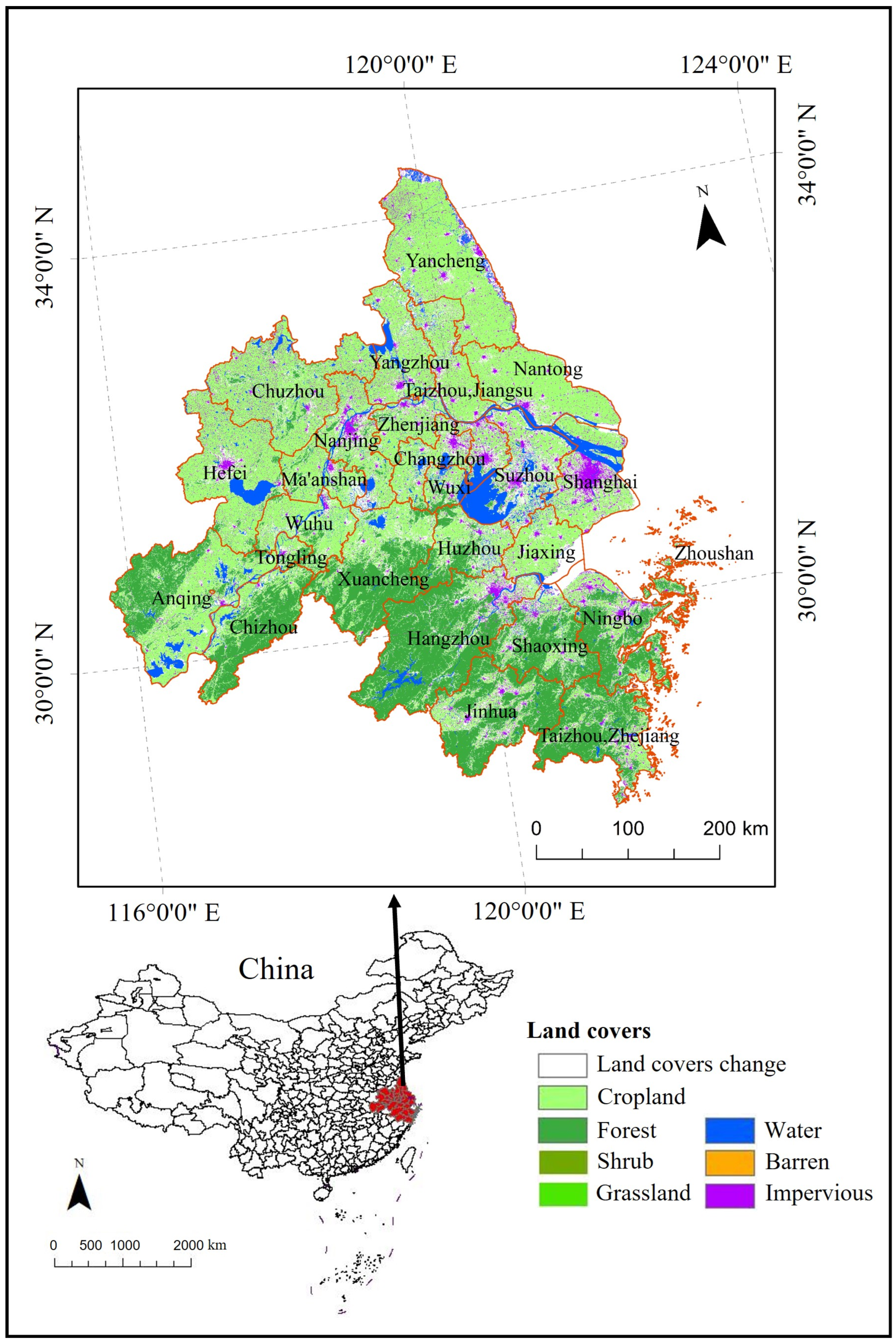

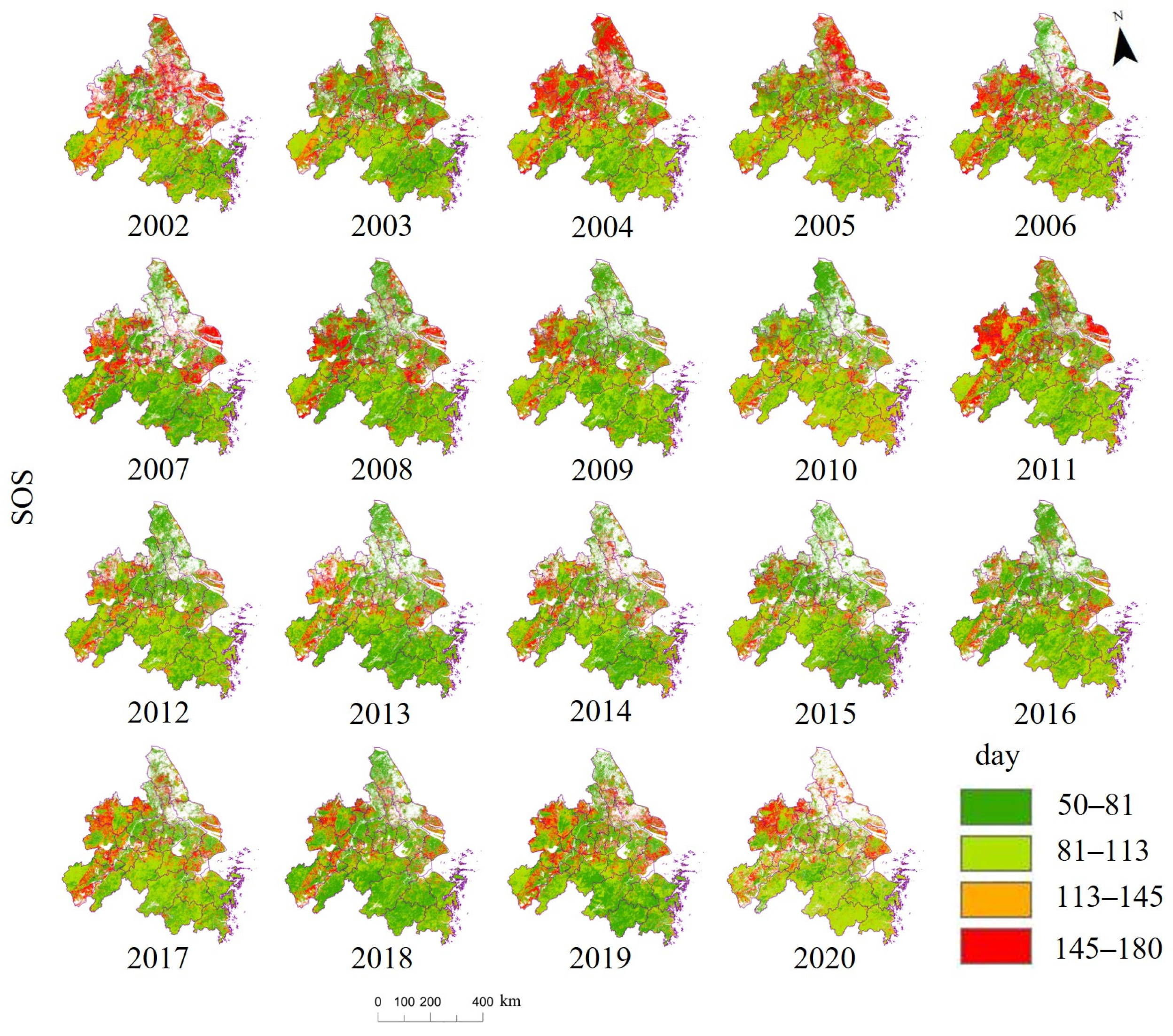
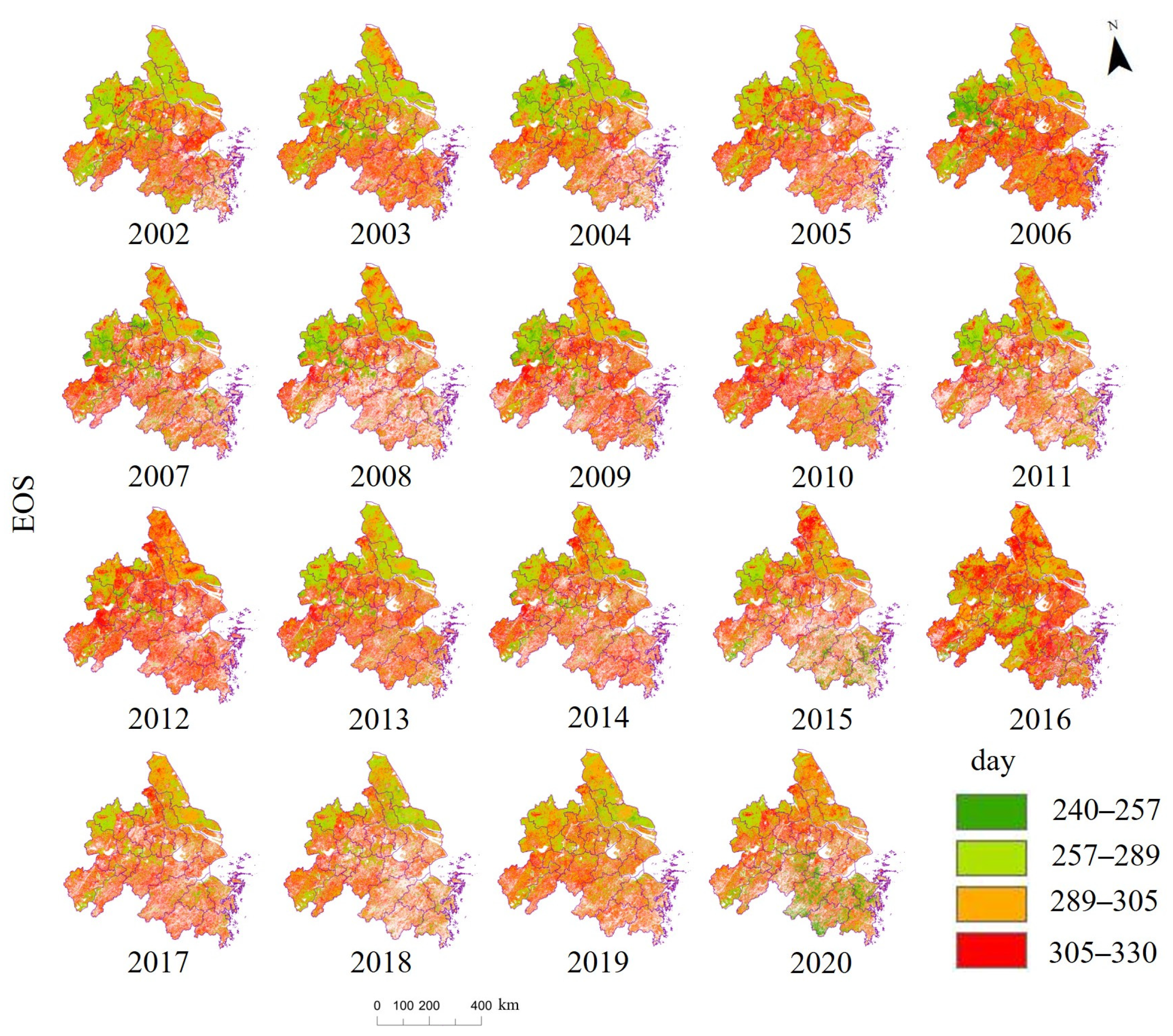
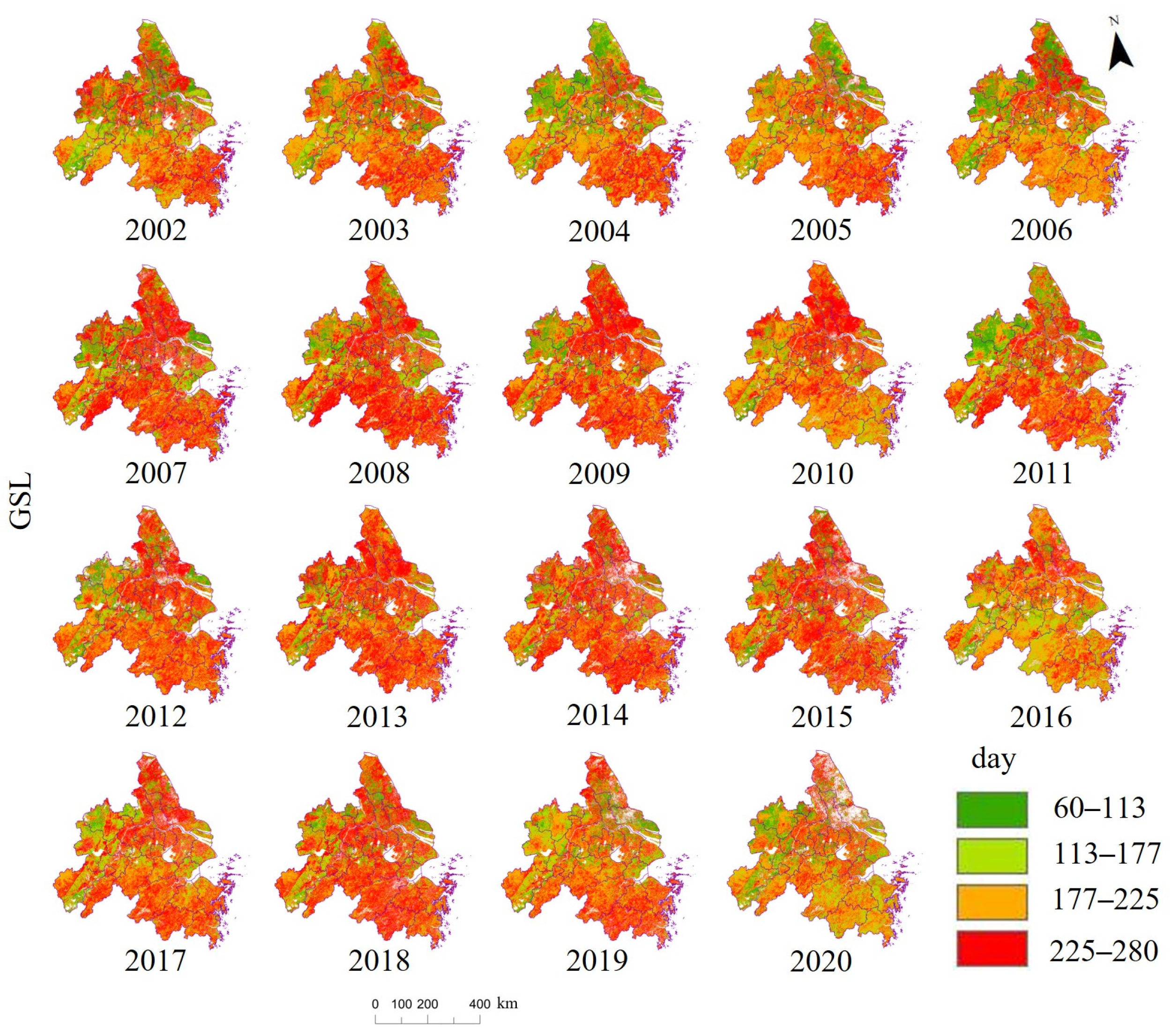
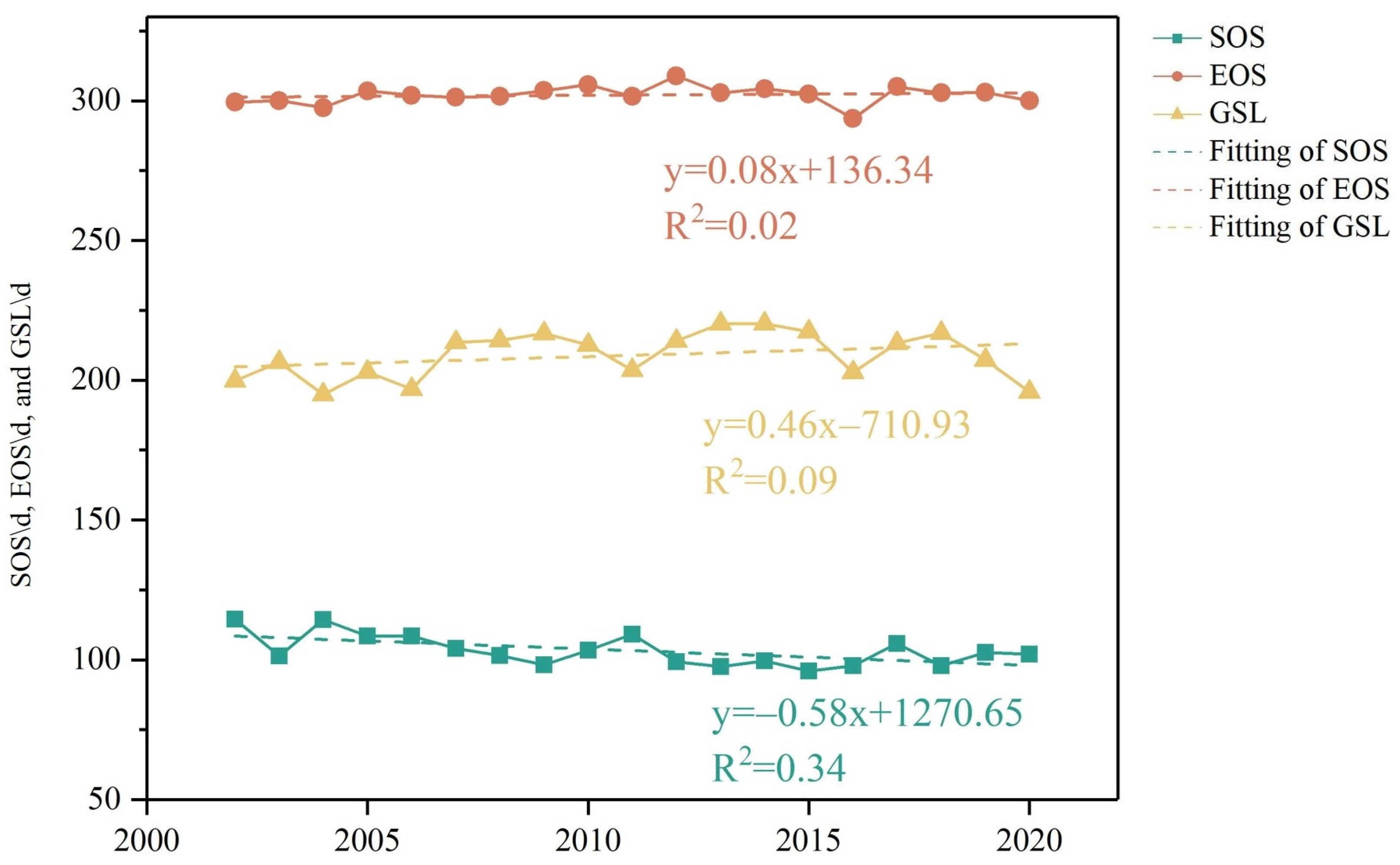
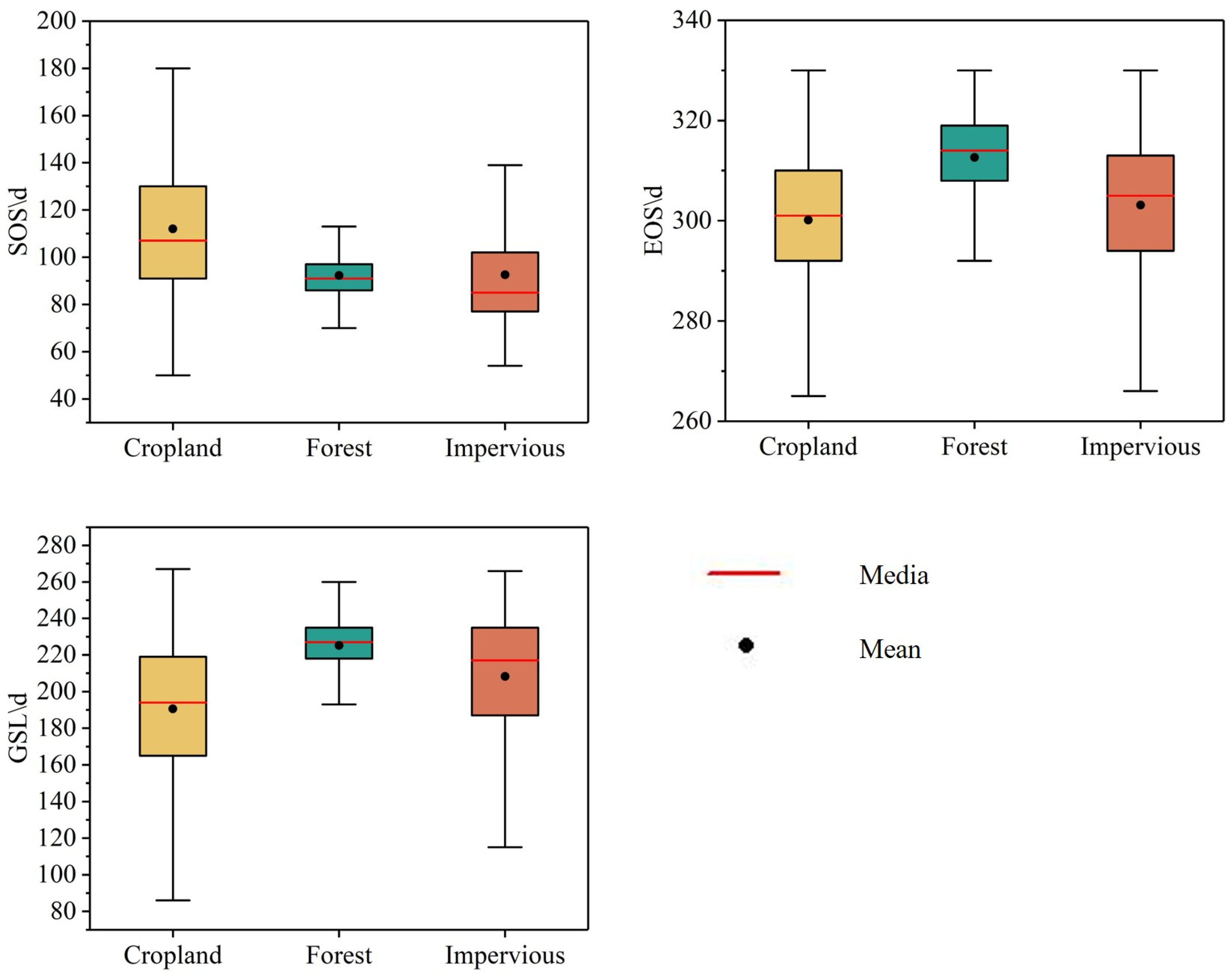
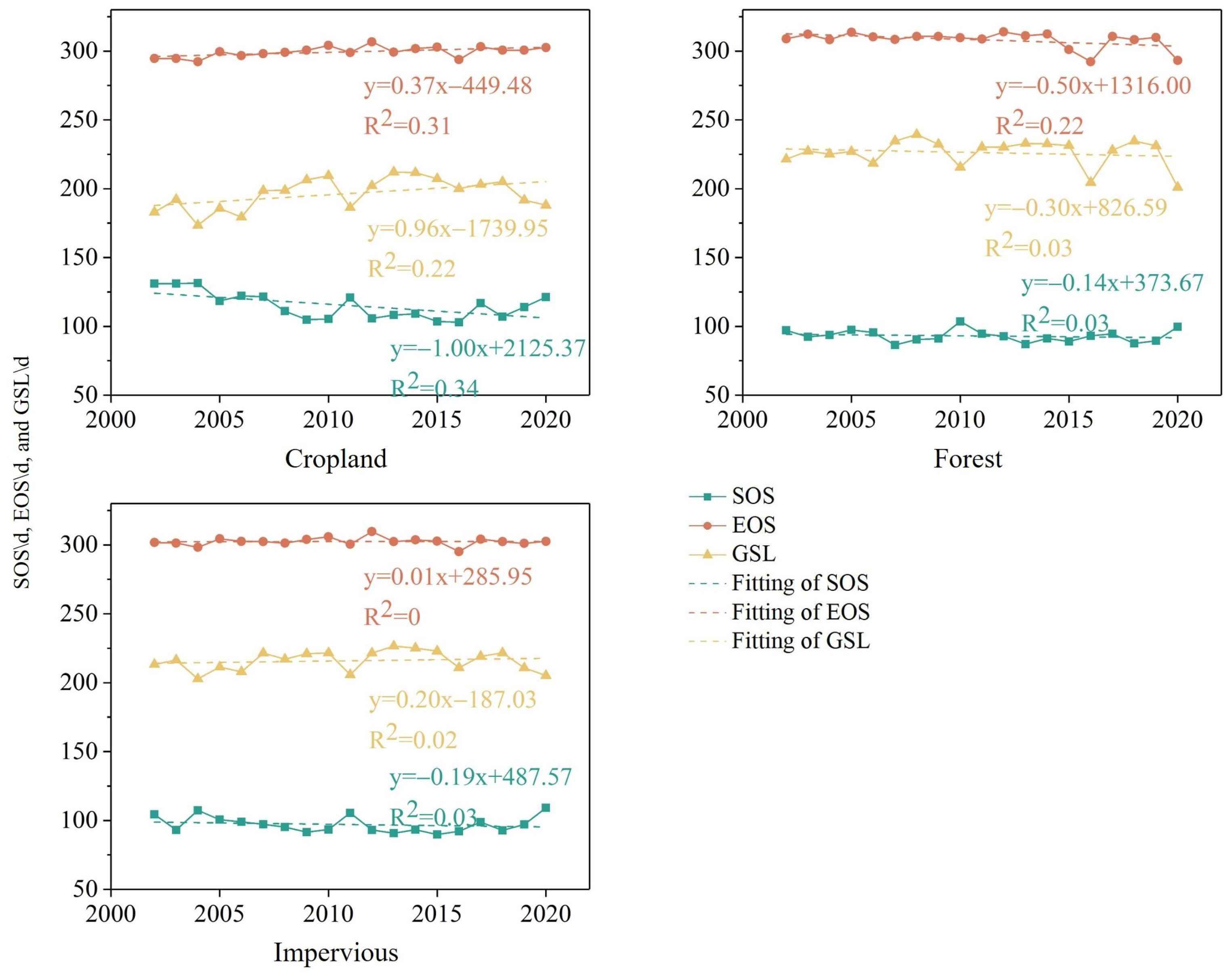
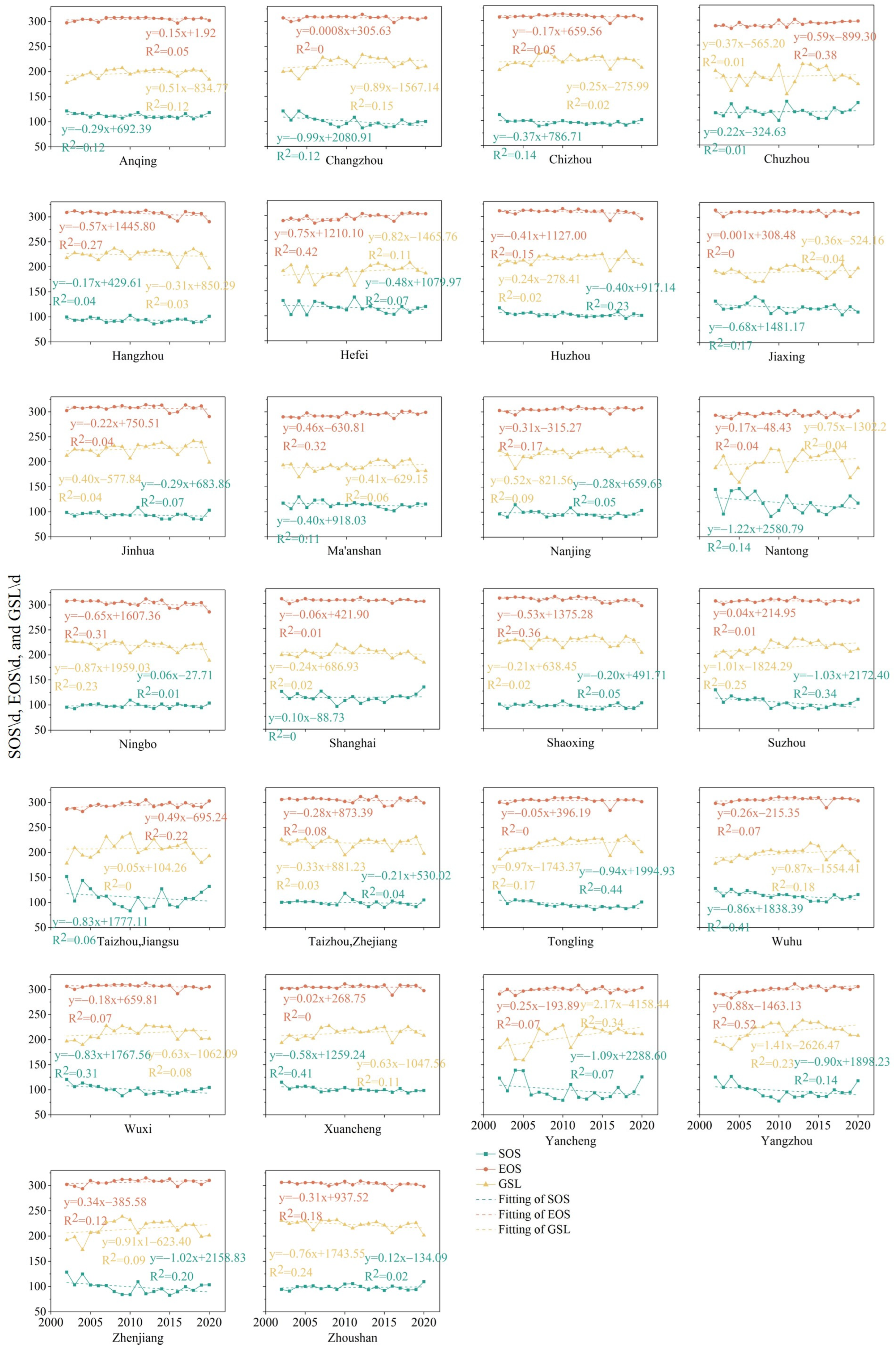

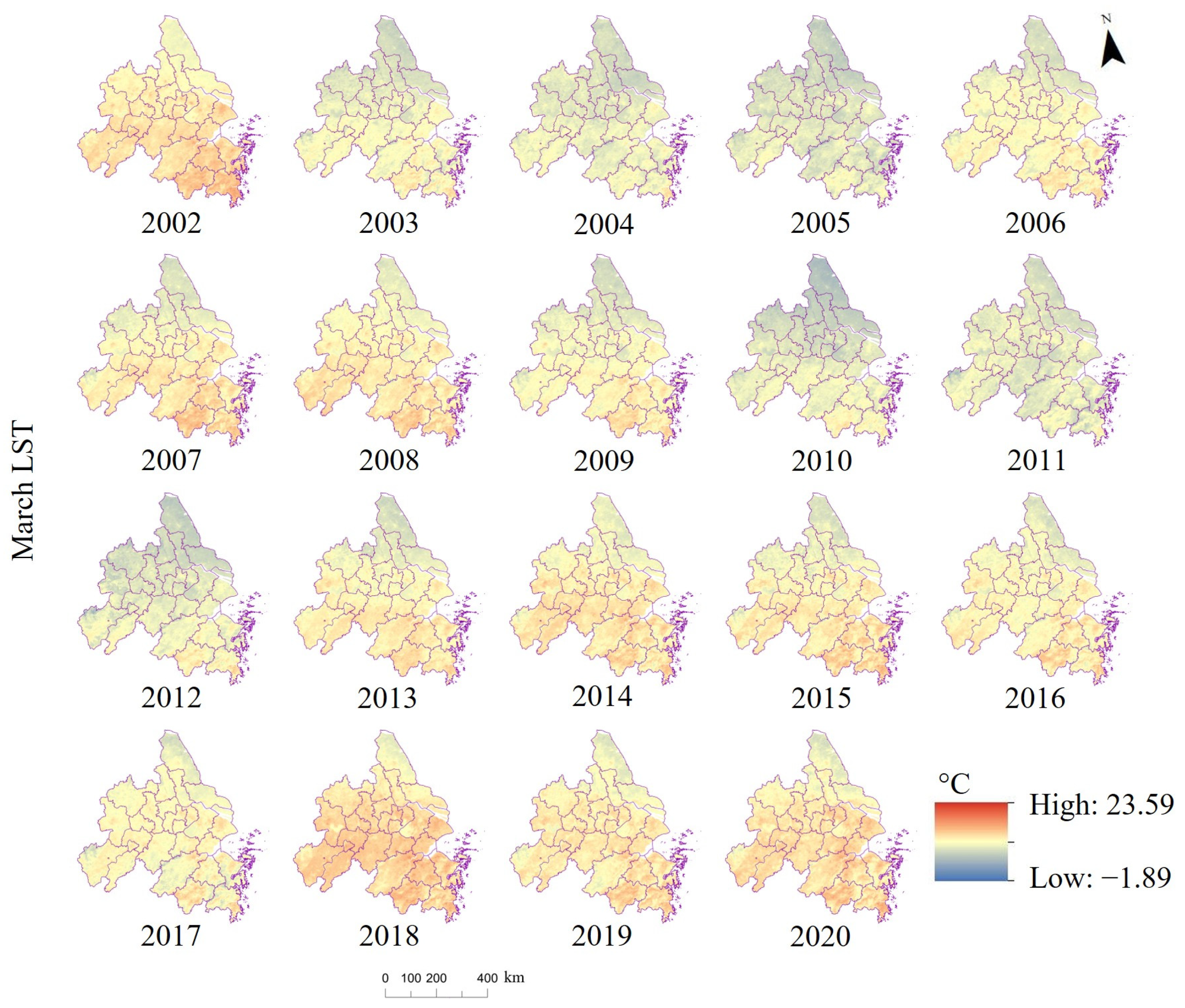

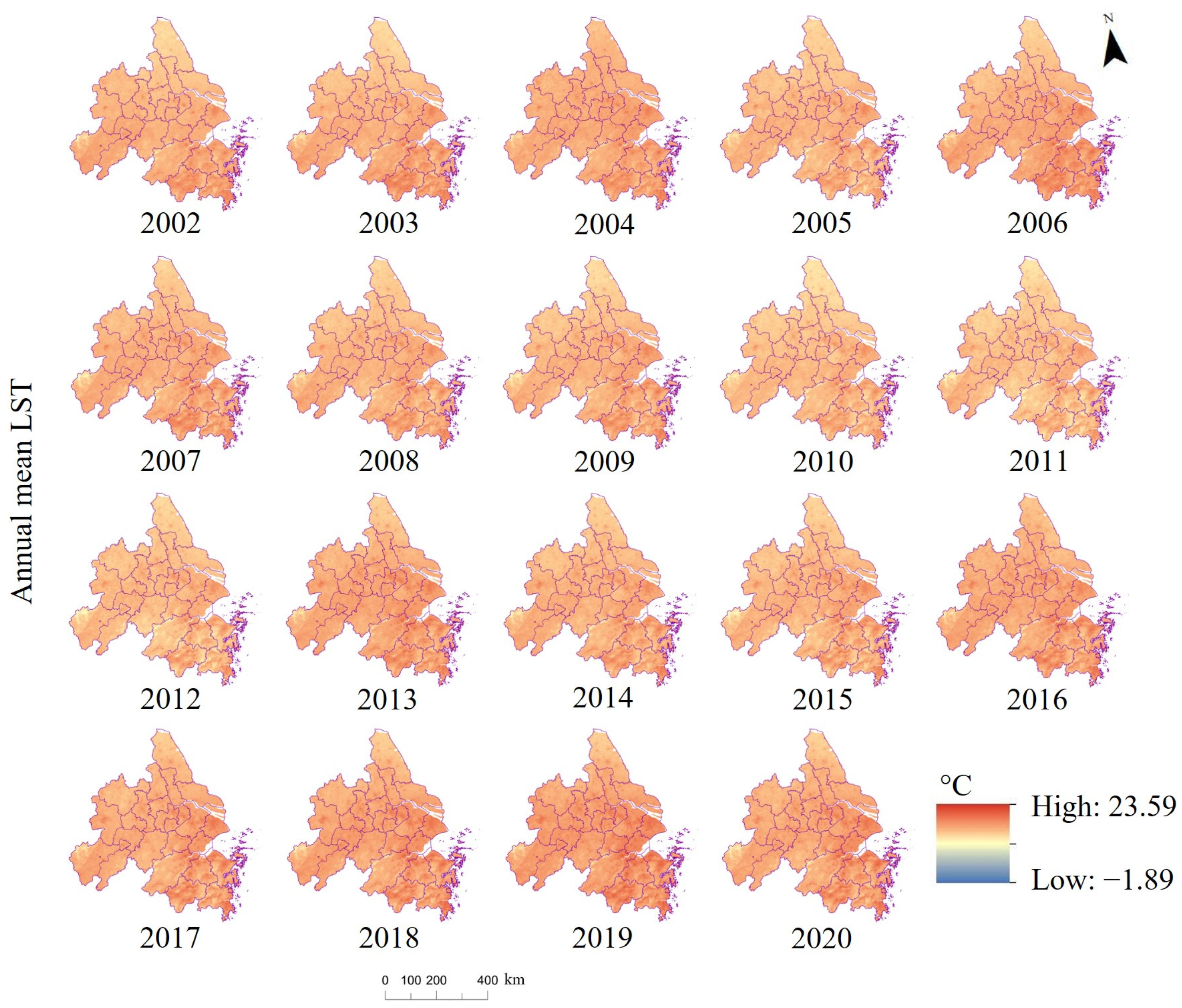
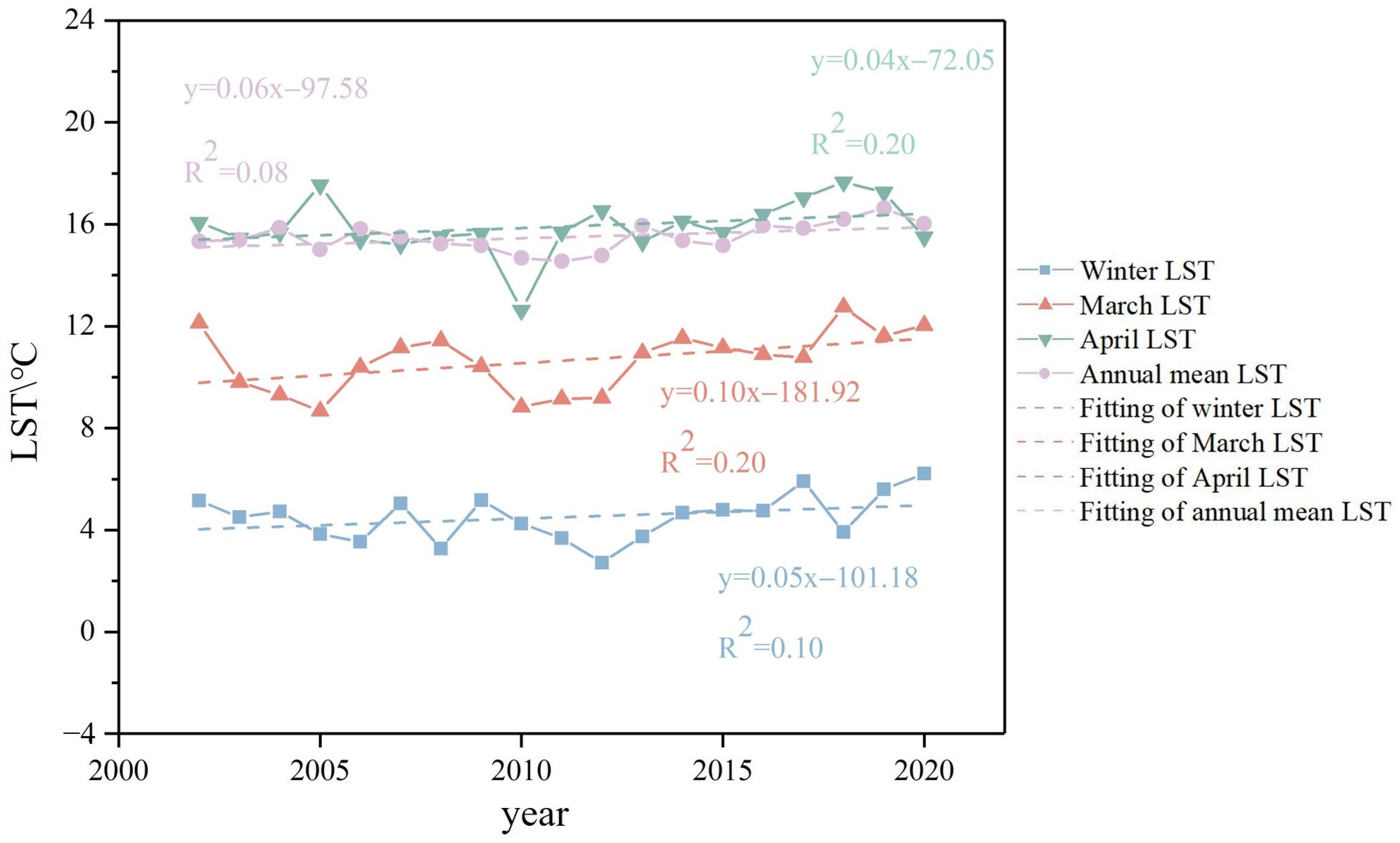

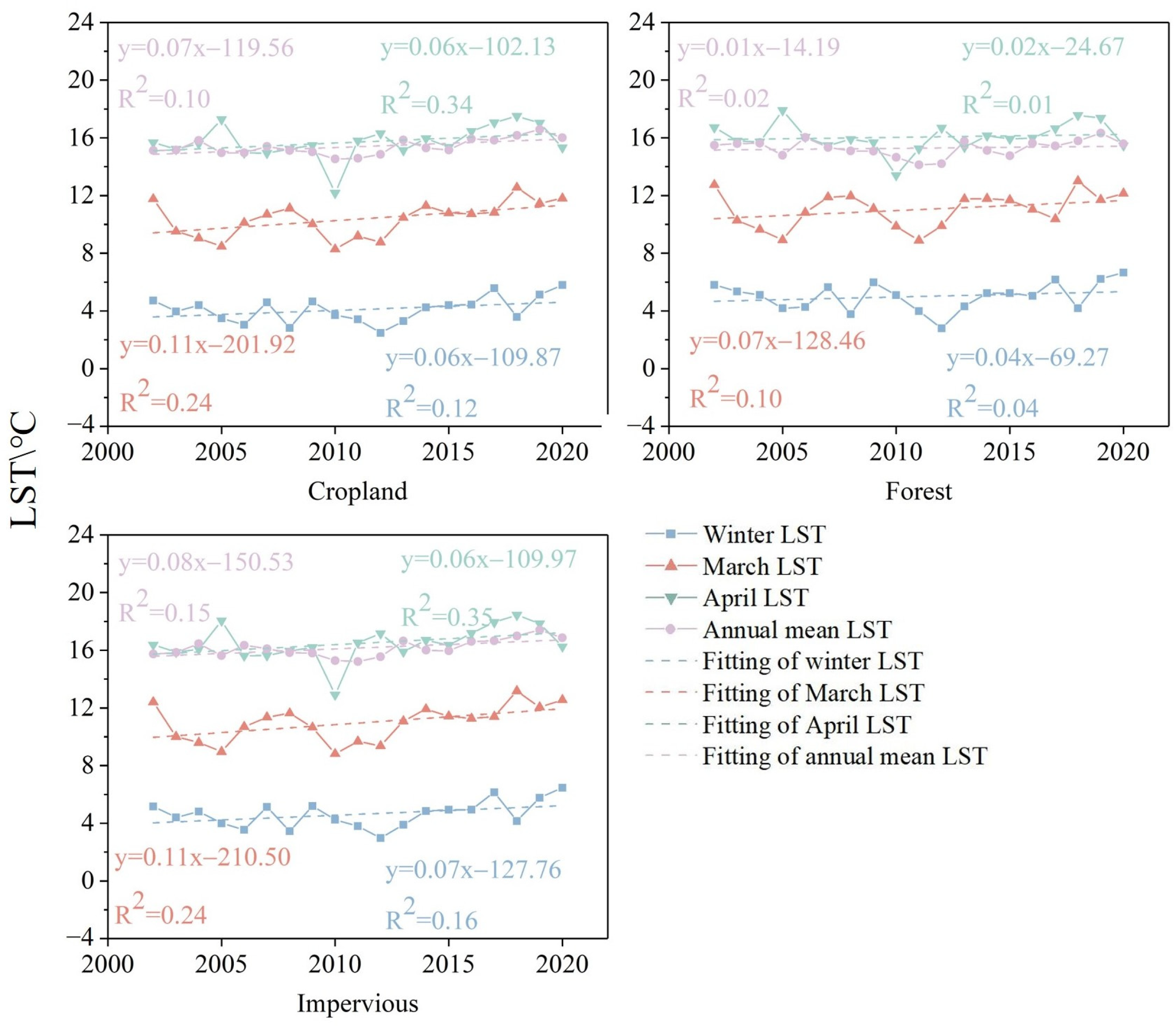
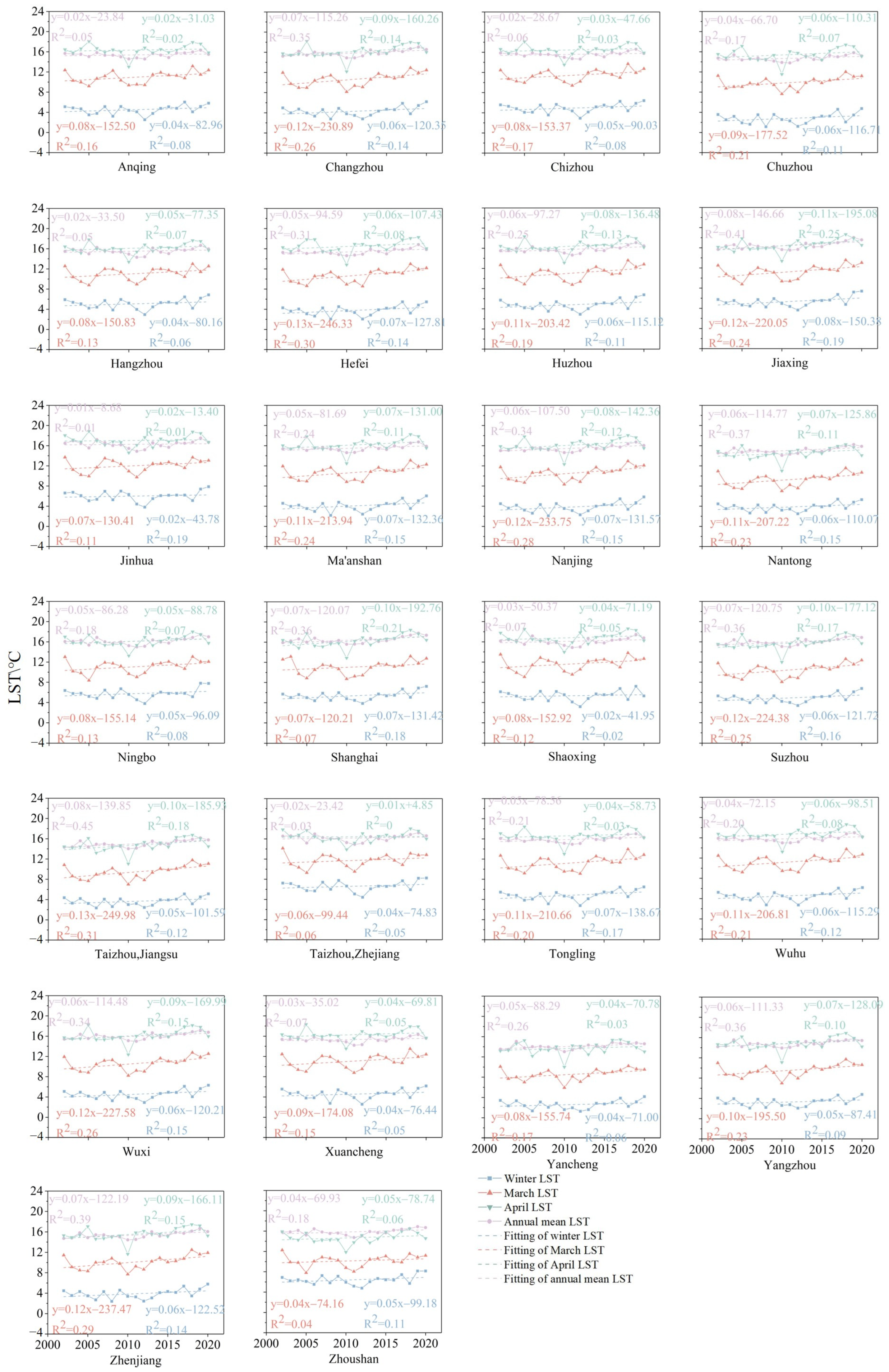
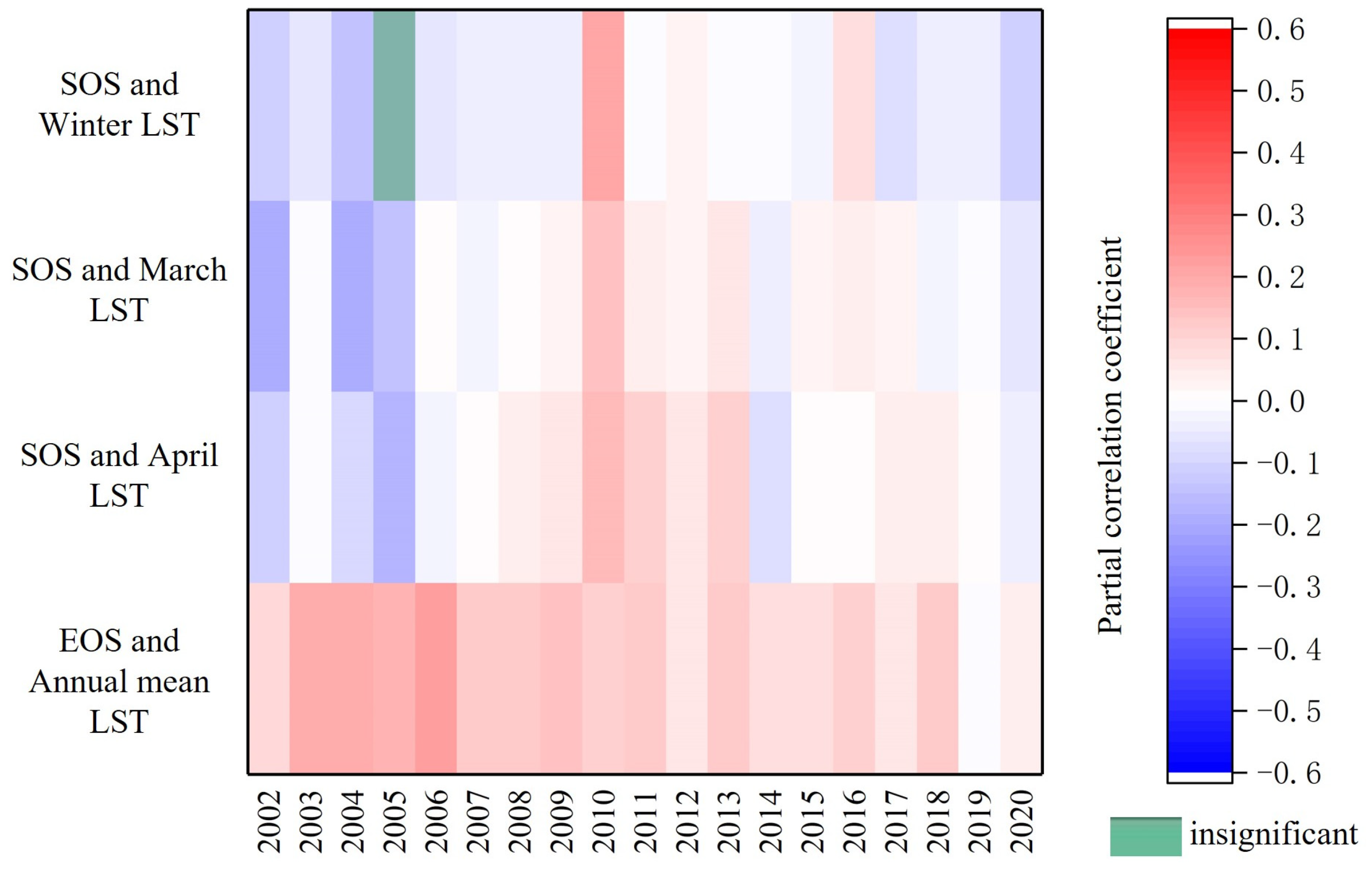
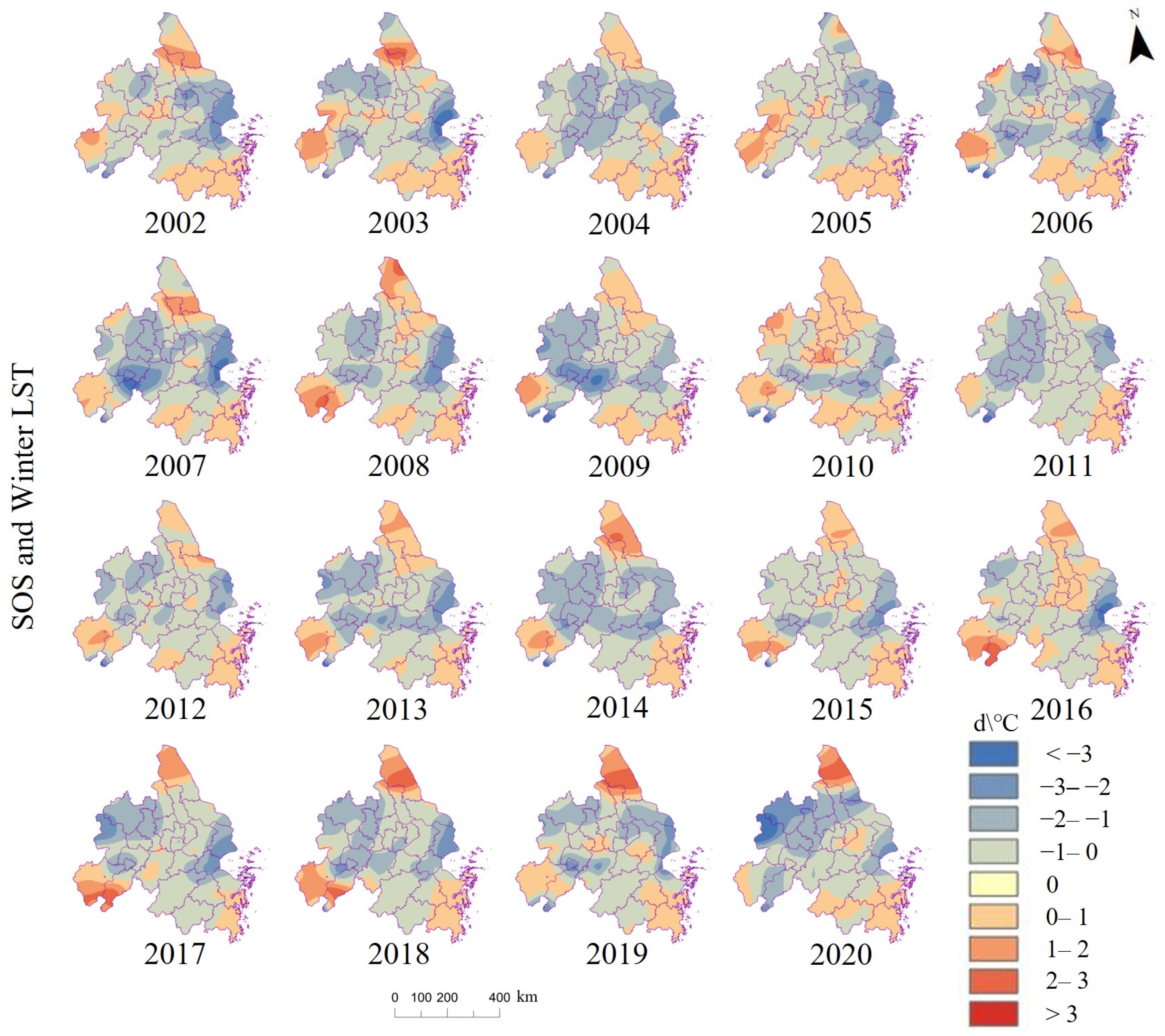

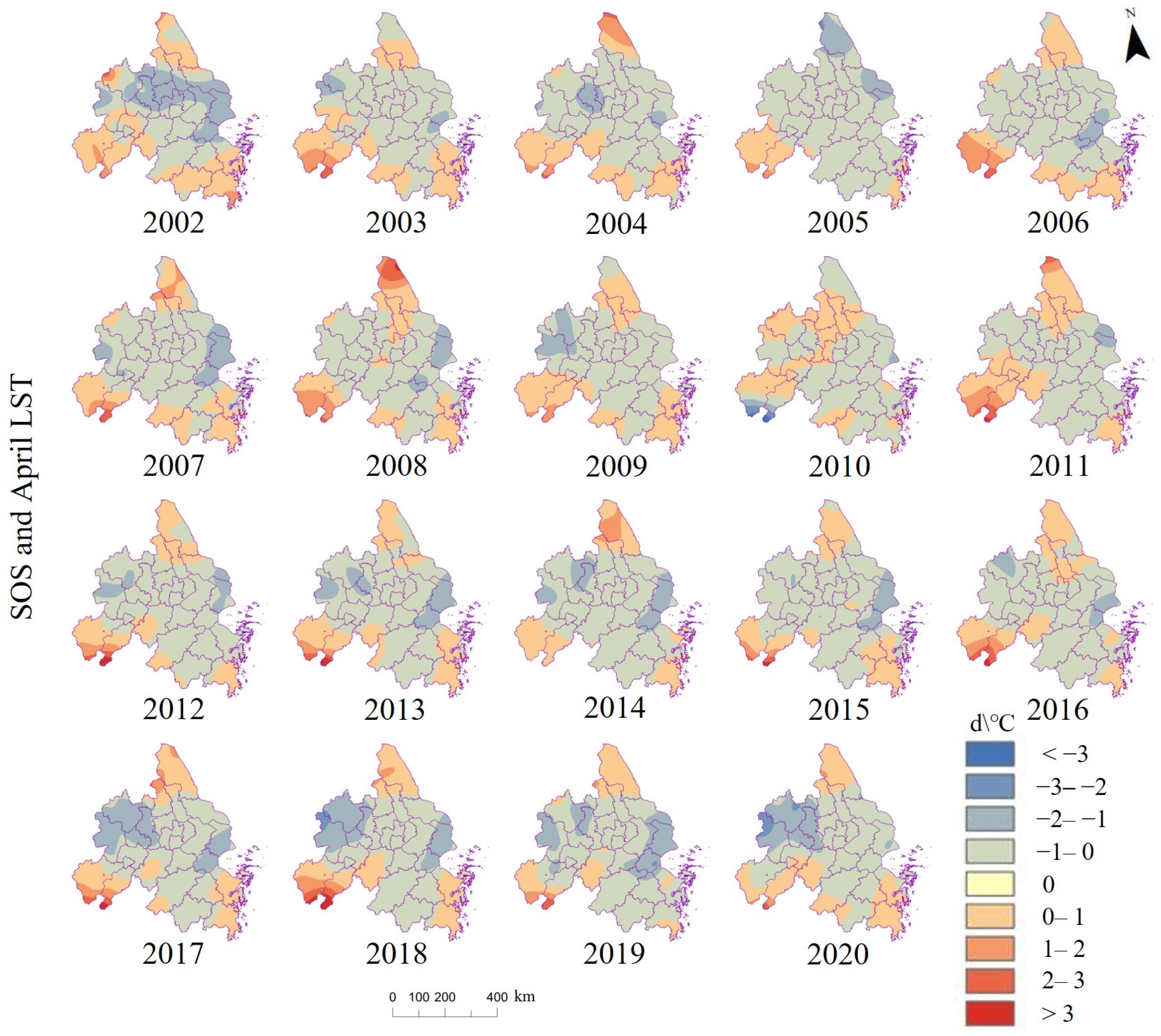

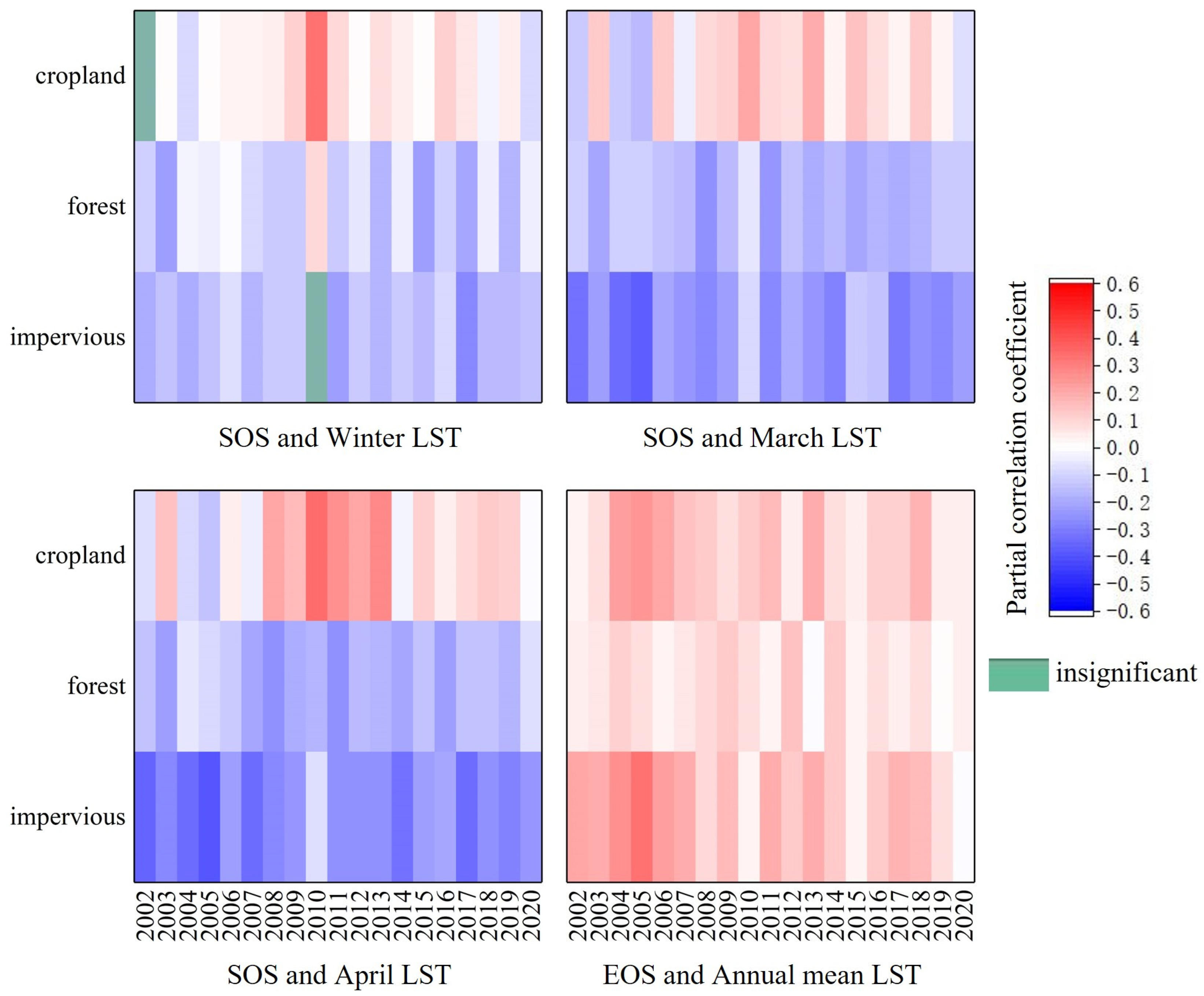
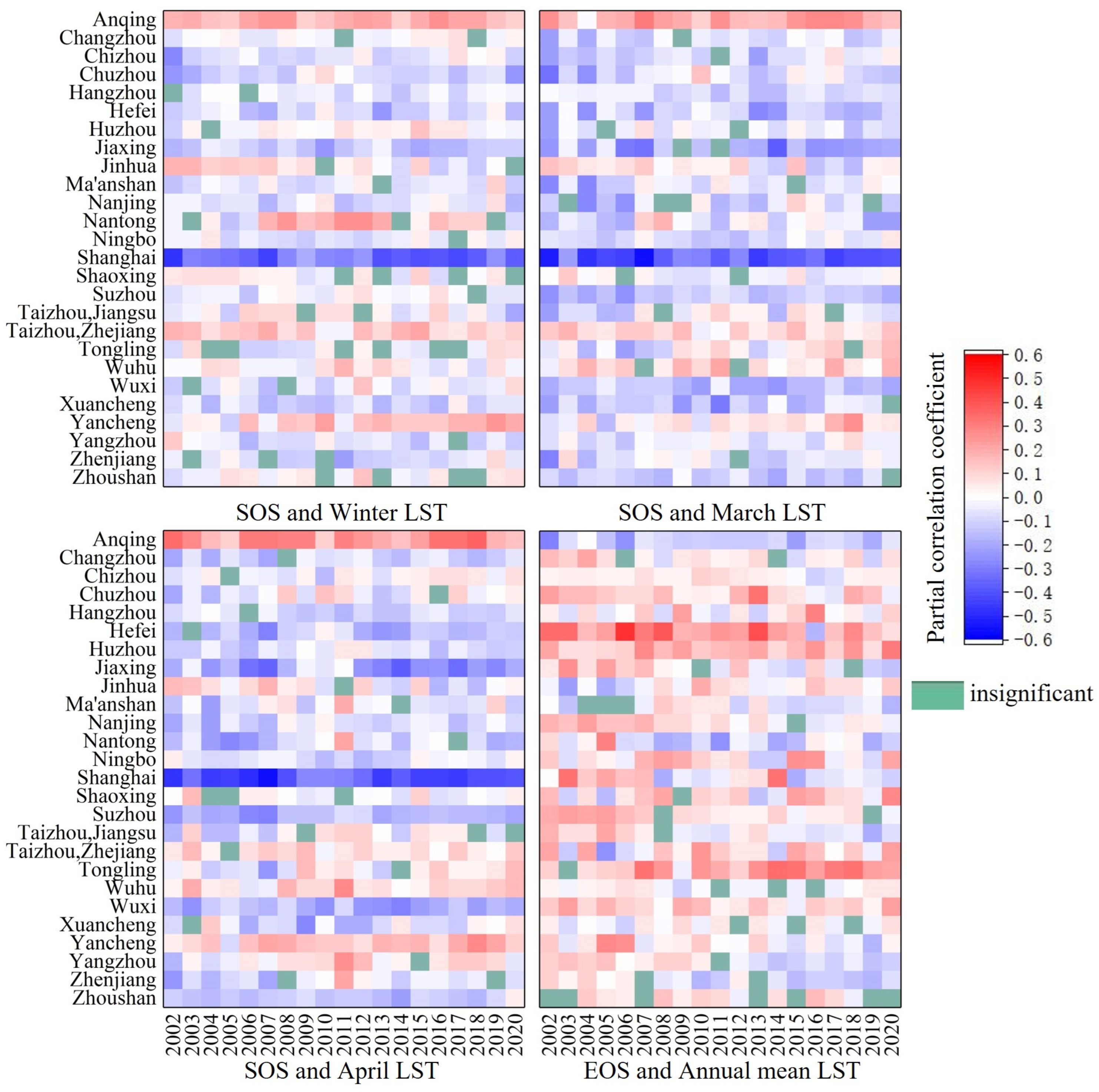

Disclaimer/Publisher’s Note: The statements, opinions and data contained in all publications are solely those of the individual author(s) and contributor(s) and not of MDPI and/or the editor(s). MDPI and/or the editor(s) disclaim responsibility for any injury to people or property resulting from any ideas, methods, instructions or products referred to in the content. |
© 2024 by the authors. Licensee MDPI, Basel, Switzerland. This article is an open access article distributed under the terms and conditions of the Creative Commons Attribution (CC BY) license (https://creativecommons.org/licenses/by/4.0/).
Share and Cite
Yang, Y.; Yao, L.; Fu, X.; Shen, R.; Wang, X.; Liu, Y. Spatial and Temporal Variations of Vegetation Phenology and Its Response to Land Surface Temperature in the Yangtze River Delta Urban Agglomeration. Forests 2024, 15, 1363. https://doi.org/10.3390/f15081363
Yang Y, Yao L, Fu X, Shen R, Wang X, Liu Y. Spatial and Temporal Variations of Vegetation Phenology and Its Response to Land Surface Temperature in the Yangtze River Delta Urban Agglomeration. Forests. 2024; 15(8):1363. https://doi.org/10.3390/f15081363
Chicago/Turabian StyleYang, Yi, Lei Yao, Xuecheng Fu, Ruihua Shen, Xu Wang, and Yingying Liu. 2024. "Spatial and Temporal Variations of Vegetation Phenology and Its Response to Land Surface Temperature in the Yangtze River Delta Urban Agglomeration" Forests 15, no. 8: 1363. https://doi.org/10.3390/f15081363
APA StyleYang, Y., Yao, L., Fu, X., Shen, R., Wang, X., & Liu, Y. (2024). Spatial and Temporal Variations of Vegetation Phenology and Its Response to Land Surface Temperature in the Yangtze River Delta Urban Agglomeration. Forests, 15(8), 1363. https://doi.org/10.3390/f15081363






